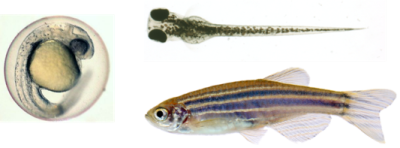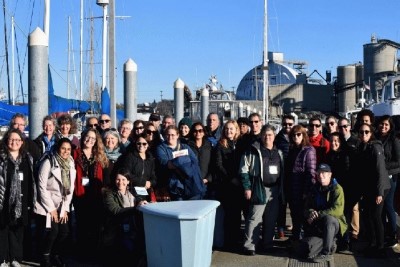Hot Off the Press
The Superfund Research Program (SRP) regularly highlights basic and applied research and activities from the program that span multiple disciplines.
Research Briefs
High-Fiber Diet May Protect Against Harmful Health Effects of PCBs
Two new NIEHS-funded SRP studies showed how a type of dietary fiber, inulin, may protect against heart disease, including heart disease resulting from exposure to polychlorinated biphenyls (PCBs). Inulin is found in vegetables such as asparagus and onions. According to University of Kentucky SRP Center researchers, a diet high in inulin may reduce or modify certain lipids associated with an increased chance of developing cardiovascular problems and may protect against adverse cardiovascular effects caused by environmental toxicants, such as PCBs.

PAH and Hypoxia Exposure Result in Mitochondrial Dysfunction in Fish
Exposure to polycyclic aromatic hydrocarbons (PAHs) as well as inadequate oxygen supply, or hypoxia, can lead to a broad range of effects on the mitochondria of zebrafish, according to an SRP-funded study. Changes to the function and integrity of mitochondria, which are organelles that make energy for the cell, can disrupt metabolism and reduce organism fitness and performance. Duke University SRP Center researchers led by trainee Casey Lindberg, Ph.D., and project leader Richard Di Giulio, Ph.D., used zebrafish as a model to study the potential interactions between PAHs and hypoxia and their effect on mitochondria.
Cadmium Exposure Impairs Production of Neurons Responsible for Learning and Memory
A new study funded by the SRP shows cadmium exposure can impair new neurons from forming and maturing in the hippocampus region of the brain. Led by Zhengui Xia, Ph.D., the researchers at the University of Washington (UW) SRP Center also found that cadmium can lead to the death of stem cells that produce these neurons. In people, learning and memory formation depends on the production of new neurons in this region of the brain.
Environmental Factor Articles

Oral Histories Shed Light on Exposures Near Superfund Sites
A new collection of oral histories from people who work and live near two Arizona Superfund sites was posted online in January. The community-driven Voices Unheard project captures video accounts, photos, and descriptions from communities near the Tucson International Airport Area and the Iron King Mine-Humboldt Smelter Superfund sites. The collection was developed as part of the graduate work of Denise Moreno Ramirez, a trainee at the NIEHS-funded University of Arizona SRP Center.
Exposure Research Bolstered by New NIEHS Resource
The Human Health Exposure Analysis Resource (HHEAR) promises to strengthen research on how chemical, biological, and social stressors influence health. The program will assist eligible grant recipients who seek to include such analyses in their studies. Affiliated grant recipients, including those from the SRP, can apply.
Paper of the Month: New Quick Screen for Different Types of DNA Damage
Massachusetts Institute of Technology (MIT) SRP Center grant recipients and colleagues developed a new screening method that can detect a broad range of DNA damage in cells. According to the authors, this new method fills a gap in DNA damage testing and could make chemical safety testing faster, easier, and more accurate.

River Tour During SRP Meeting Spotlights Local Perspectives
The UW SRP Center organized a boat tour of the Lower Duwamish Waterway Superfund site, which took place on the last day of the SRP Annual Meeting. Attendees learned about cleanup, ecological restoration, and community involvement efforts taking place at the site.
SRP Risk e-Learning Webinar Series: Exposures and Latent Disease Risk
SRP is hosting a Risk e-Learning webinar series focused on exposures and latent disease risk. The series will feature SRP grant recipients and colleagues who are studying how we can better understand the health effects of exposures when there is a long latency period between the exposure and the onset of the disease.
The first session, Linking Exposures to Diseases with Long Latency Periods ,will be held May 11, 2020, 1:00 - 3:00 p.m. EDT. This session will provide an introduction to exposures and latent disease risk, including information about windows of susceptibility and later-life health outcomes, and will set the stage for the other sessions. Speakers include Rebecca Fry, Ph.D., from the University of North Carolina SRP Center, Brian Berridge, D.V.M., Ph.D., from the National Toxicology Program, Heather Stapleton, Ph.D., from the Duke University SRP Center, and Seth Kullman, Ph.D., of the North Carolina State University and Duke SRP Centers.
In the second session, Identifying Hallmarks and Key Characteristics ,presenters will discuss new methods to help better understand potential disease risk by identifying hallmarks or key characteristics associated with disease. These methods may provide a way to link exposures to disease earlier in the disease's progression. Speakers include Martyn Smith, Ph.D., from the University of California, Berkeley SRP Center, Michele La Merrill, Ph.D., from University of California, Davis, and Ron Kohanski, Ph.D., from the National Institute on Aging.
We are also scheduling two additional sessions on arsenic as a case study of exposures and latent disease risk, as well as emerging toxicology and modeling methods. Information will be added to the SRP Risk e-Learning website as it becomes available.
to Top



